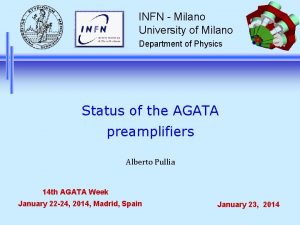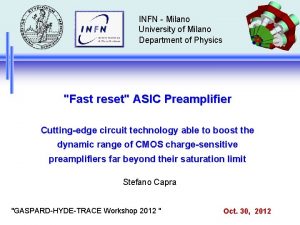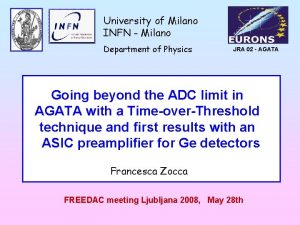INFN Milano University of Milano Department of Physics





- Slides: 5

INFN - Milano University of Milano Department of Physics Status of the AGATA preamplifiers Alberto Pullia 14 th AGATA Week January 22 -24, 2014, Madrid, Spain January 23, 2014

Milano Preamp Repair On December 15 th 2013 I received 21 Milano preamps from IKP Cologne All of them could be repaired. They have been sent back to IKP on Jan 14 th 2014 In detail these problems have been found • Output transistor of first stage and/or opamp of second stage (buffer) burnt out • Bad connection of two devices (U 4 to U 5) • Broken capacitance, resistor or via Cause: This is most probably related to the accidental detector warm up Cause: trace or footprint or soldering point defective. Wearing effect? Unclear. Cause: Wearing effect

Summary Table Progr Preamp Series Preamp # Problem Fix Modified* 1 1 9 2 chs, burnt trans Q 5 and opamp U 1 devices changed not feasible 2 1 15 1 ch, bad trace comp (U 4) to OR (U 5) wire connection added not feasible 3 4 5 1 19 26 55 3 chs, bad resistor in LDO (Ry 6) 1 ch, burnt trans (Q 5) 2 chs, trans Q 5 and opamp U 1 resistor changed devices changed not feasible 6 2 19 3 chs, burnt PS capacitor (Cx 1) and 2012 modification missing* capacitor changed yes 7 3 39 wire connection added yes 8 3 40 wire connection added yes 9 3 44 wire connection added yes 10 3 65 wire connection added yes 11 3 69 2 chs, bad trace comp (U 4) to OR (U 5) and 2012 modification missing* wire connection added yes 12 4 8. b defective via in P/Z stage wire connection added previously set 13 14 15 16 17 18 4 4 4 22. b 25. b 32. b 33. b 34. b 37. b 2012 modification missing* 2012 modification missing * 2012 modification missing * - yes yes yes 19 4 48. b 2 chs, bad trace 12 V and burnt opamps wire connection added, devices changed previously set 20 21 4 4 62. b 68. b 2012 modification missing * - yes *Config 1 ch, bad trace comp (U 4) to OR (U 5) and 2012 modification missing* 1 (Series 1, 2 and 3 only) and config 2 (all Series except 1)

Dual-Core Preamp Gain Nominal value for gains: 100 m. V/Me. V± 10% (low range ch) (from original 200 m. V/Me. V) 55 m. V/Me. V± 10% (high range ch) (from original 50 m. V/Me. V) Dual-Core Preamps occasionally show 66 m. V/Me. V instead of 100 m. V/Me. V Cause: 1 kohm resistor for gain change from 200 m. V/Me. V to 100 m. V/Me. V installed twice (issue found by G. Pascovici) We should introduce a new policy here Any change in preamplifiers MUST be communicated to me and/or George so that we can evaluate the change and track the modifications. No exception.

Conversion factor calibration for ATC 5; ADC 1 In November 2013 the conversion factor of a few Dual Core Preamps has been measured by G. Pascovici @ IKP * Deviation respect to Low gain the by design values: “ 55 m. V/Me. V ” 100 m. V/Me. V and 55 (18 Me. V_range) m. V/Me. V Detector/ Channel High gain “ 100 m. V/Me. V ” (10 Me. V_Range) ATC 5/A_004* 115 62. 7 +15. 0% / +14. 0% ATC 5/B_002 98. 0 52. 6 -2. 0% / -4. 5% ATC 5/C_009 98. 5 53. 0 -1. 5% / -3. 6% ADC 1/B_004 104. 0 58. 1 +4. 0% / +6. 7% ADC 1/C_006 93. 8 *** 52. 7 -6. 2% / -4. 5% Within a limit of +/- 1. 5 %, the conversion factors are almost independent of the warm part of the preamplifiers ** Detector ATC 5/A shows still instabilities (leakage current fluctuation), after reopening it the detector group will change also the feedback components (namely, the 1 p. F capacitor and 1 GOhm resistor) *** In detector ADC 1/C_006 we found on the Core CSP_“High gain” channel two 1 KOhm soldered in parallel…this is indeed, a quite unpleasant human error! In this way, the gain of that stage was changed from 2 to 1. 5 and correspondingly, the calibration factor changed from 100 m. V/Me. V to 66. 6 m. V/Me. V ! Such “in situ” changes have to be registered in a notebook, if not reported to the detector group







